Statistics as a discipline
2 likes702 views
Statistics is the collection, organization, analysis, and presentation of data. It has become important for professionals, scientists, and citizens to make sense of large amounts of data. Statistics are used across many disciplines from science to business. There are two main types of statistical methods - descriptive statistics which summarize data through measures like the mean and median, and inferential statistics which make inferences about populations based on samples. Descriptive statistics describe data through measures of central tendency and variability, while inferential statistics allow inferences to be made from samples to populations through techniques like hypothesis testing.
1 of 19
Download to read offline
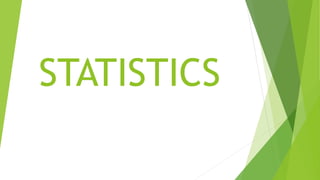
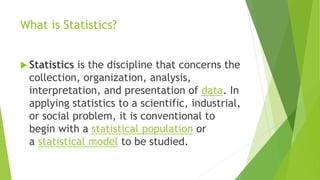
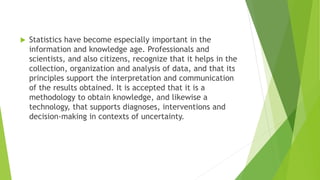
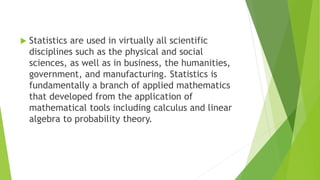
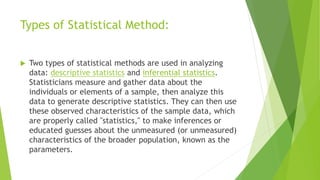
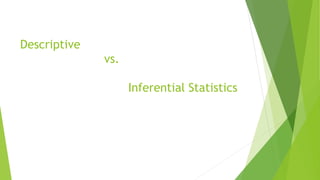


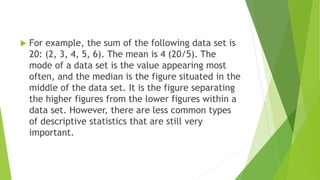
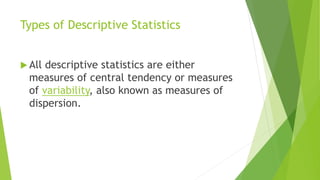
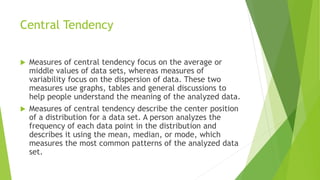

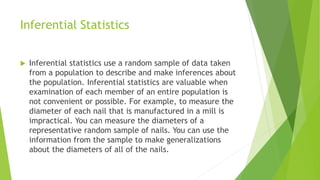
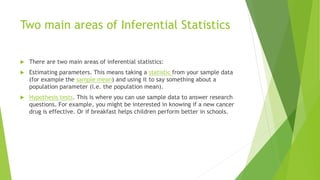
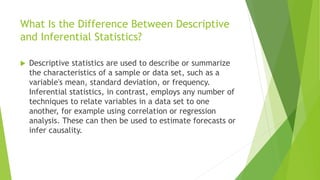
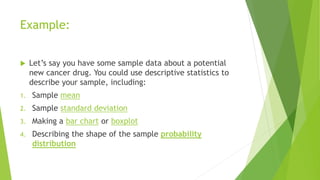


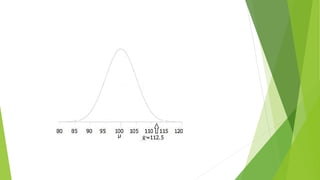
Ad
Recommended
Measures of Variation



Measures of VariationSamuel John Parreño In this lesson, students will be shown that it is not enough to get measures of central tendency in a data set by scrutinizing two different data sets with the same measures of central tendency. We illustrate this using data on the returns on stocks where it is not only the mean, median and mode which are the same, it is also true for other measures of location like its minimum and maximum. However, the spread of observations are different which means that to further describe the data sets we need additional measures like a measure about the dispersion of the data, i.e. range, interquartile range, variance, standard deviation, and coefficient of variation. Also, the standard deviation, as a measure of dispersion can be viewed as a measure of risk, specifically in the case of making investments in stock market. The smaller the value of the standard deviation, the smaller is the risk.
Measures of Variability



Measures of VariabilityMary Krystle Dawn Sulleza This document discusses measures of variability, which refer to how spread out a set of data is. Variability is measured using the standard deviation and variance. The standard deviation measures how far data points are from the mean, while the variance is the average of the squared deviations from the mean. To calculate the standard deviation, you take the square root of the variance. This provides a measure of variability that is on the same scale as the original data. The standard deviation and variance are widely used statistical measures for quantifying the spread of a data set.
Data Analysis and Statistics



Data Analysis and StatisticsT.S. Lim This document provides an overview of data analysis and statistics concepts for a training session. It begins with an agenda outlining topics like descriptive statistics, inferential statistics, and independent vs dependent samples. Descriptive statistics concepts covered include measures of central tendency (mean, median, mode), measures of variability (range, standard deviation), and charts. Inferential statistics discusses estimating population parameters, hypothesis testing, and statistical tests like t-tests, ANOVA, and chi-squared. The document provides examples and online simulation tools. It concludes with some practical tips for data analysis like checking for errors, reviewing findings early, and consulting a statistician on analysis plans.
Introduction to Statistics and Statistical Inference



Introduction to Statistics and Statistical InferenceJezhabeth Villegas This document provides an introduction to teaching basic statistics for tertiary level teachers. It covers key topics in statistics including definitions, areas of statistics, variables, levels of measurement, methods of collecting and presenting data, measures of central tendency and location, and more. Florence Nightingale is quoted emphasizing the importance of statistics. Realities about how statistics are viewed and applied in diverse fields are also discussed.
Introduction to Descriptive Statistics



Introduction to Descriptive StatisticsSanju Rusara Seneviratne Lecture on Introduction to Descriptive Statistics - Part 1 and Part 2. These slides were presented during a lecture at the Colombo Institute of Research and Psychology.
Inferential statistics.ppt



Inferential statistics.pptNursing Path This document discusses inferential statistics, which uses sample data to make inferences about populations. It explains that inferential statistics is based on probability and aims to determine if observed differences between groups are dependable or due to chance. The key purposes of inferential statistics are estimating population parameters from samples and testing hypotheses. It discusses important concepts like sampling distributions, confidence intervals, null hypotheses, levels of significance, type I and type II errors, and choosing appropriate statistical tests.
Introduction To Statistics



Introduction To Statisticsalbertlaporte This document summarizes key concepts from an introduction to statistics textbook. It covers types of data (quantitative, qualitative, levels of measurement), sampling (population, sample, randomization), experimental design (observational studies, experiments, controlling variables), and potential misuses of statistics (bad samples, misleading graphs, distorted percentages). The goal is to illustrate how common sense is needed to properly interpret data and statistics.
Statistics "Descriptive & Inferential"



Statistics "Descriptive & Inferential"Dalia El-Shafei It is the science of dealing with numbers.
It is used for collection, summarization, presentation and analysis of data.
Levels of Measurement



Levels of MeasurementSamuel John Parreño In this lesson we discuss the different levels of measurement as we continue to explore data. Knowing such will enable us to plan the data collection process we need to employ in order to gather the appropriate data for analysis.
Descriptive statistics



Descriptive statisticsAttaullah Khan What are descriptive Statistics, Types of statistics and its implications.
graphs, tables, variation, mean mode median, central tendency,
Graphical presentation of data



Graphical presentation of datadrasifk Variables describe attributes that can vary between entities. They can be qualitative (categorical) or quantitative (numeric). Common types of variables include continuous, discrete, ordinal, and nominal variables. Data can be presented graphically through bar charts, pie charts, histograms, box plots, and scatter plots to better understand patterns and trends. Key measures used to summarize data include measures of central tendency (mean, median, mode) and measures of variability (range, standard deviation, interquartile range).
4. parameter and statistic



4. parameter and statisticONE Virtual Services Distinguish between Parameter and Statistic.
Calculate sample variance and sample standard deviation.
Visit the website for more services: https://cristinamontenegro92.wixsite.com/onevs
Introduction to Statistics - Basic concepts



Introduction to Statistics - Basic conceptsDocIbrahimAbdelmonaem Introduction to Statistics - Basic concepts
- How to be a good doctor - A step in Health promotion
- By Ibrahim A. Abdelhaleem - Zagazig Medical Research Society (ZMRS)
Basic Statistics



Basic StatisticsChie Pegollo Introduction to Basic Statistics: Definition of Terms
This presentation is made exclusively for use by the sophomores of SRSTHS
(Manual spss)



(Manual spss)Enas Ahmed The document provides instructions for launching and using the statistical software SPSS. It discusses finding the SPSS icon on the computer and launching the program. Once SPSS is open, the user can start a new data file or open an existing one. Basic steps for using SPSS are outlined, including entering data, defining variables, testing for normality, statistical analysis, and interpreting results. Specific functions and menus in SPSS are demonstrated for descriptive statistics, normality testing, and t-tests.
Measures of dispersion or variation



Measures of dispersion or variationRaj Teotia This document discusses various measures of dispersion used to describe how varied or spread out a set of data values are from the average. It describes range, interquartile range, mean deviation, standard deviation, and the Lorenz curve. Standard deviation is highlighted as the most important measure, being easy to calculate, taking all data points into account equally, and indicating how far values typically are from the average in a normal distribution. The document provides formulas and explains properties and limitations of each measure.
Basic Statistical Concepts and Methods



Basic Statistical Concepts and MethodsAhmed-Refat Refat Statistics is the science of dealing with numbers.
It is used for collection, summarization, presentation and analysis of data.
Statistics provides a way of organizing data to get information on a wider and more formal (objective) basis than relying on personal experience (subjective).
descriptive and inferential statistics



descriptive and inferential statisticsMona Sajid This document discusses various statistical methods used to organize and interpret data. It describes descriptive statistics, which summarize and simplify data through measures of central tendency like mean, median, and mode, and measures of variability like range and standard deviation. Frequency distributions are presented through tables, graphs, and other visual displays to organize raw data into meaningful categories.
Descriptive statistics



Descriptive statisticsAbdelrahman Alkilani This document discusses descriptive statistics used in research. It defines descriptive statistics as procedures used to organize, interpret, and communicate numeric data. Key aspects covered include frequency distributions, measures of central tendency (mode, median, mean), measures of variability, bivariate descriptive statistics using contingency tables and correlation, and describing risk to facilitate evidence-based decision making. The overall purpose of descriptive statistics is to synthesize and summarize quantitative data for analysis in research.
Statistical Data Analysis | Data Analysis | Statistics Services | Data Collec...



Statistical Data Analysis | Data Analysis | Statistics Services | Data Collec...Stats Statswork The present article helps the USA, the UK and the Australian students pursuing their business and marketing postgraduate degree to identify right topic in the area of marketing in business. These topics are researched in-depth at the University of Columbia, brandies, Coventry, Idaho, and many more. Stats work offers UK Dissertation stats work Topics Services in business. When you Order stats work Dissertation Services at Tutors India, we promise you the following – Plagiarism free, Always on Time, outstanding customer support, written to Standard, Unlimited Revisions support and High-quality Subject Matter Experts.
Contact Us:
Website: www.statswork.com
Email: info@statswork.com
UnitedKingdom: +44-1143520021
India: +91-4448137070
WhatsApp: +91-8754446690
Introduction to statistics 2013



Introduction to statistics 2013Mohammad Ihmeidan This document provides an introduction to statistics and statistical concepts. It covers topics such as course objectives, purposes of statistics, population and sampling, types of data and variables, levels of measurement, and nominal level of measurement. The key points are that statistics can describe, summarize, predict and identify relationships in data, and that there are different levels of variables from nominal to ratio scales.
Basic Statistics & Data Analysis



Basic Statistics & Data AnalysisAjendra Sharma Statistics is the methodology used to interpret and draw conclusions from collected data. It provides methods for designing research studies, summarizing and exploring data, and making predictions about phenomena represented by the data. A population is the set of all individuals of interest, while a sample is a subset of individuals from the population used for measurements. Parameters describe characteristics of the entire population, while statistics describe characteristics of a sample and can be used to infer parameters. Basic descriptive statistics used to summarize samples include the mean, standard deviation, and variance, which measure central tendency, spread, and how far data points are from the mean, respectively. The goal of statistical data analysis is to gain understanding from data through defined steps.
Statistics lesson 1



Statistics lesson 1Katrina Mae Statistics involves collecting, organizing, analyzing, and interpreting data. Descriptive statistics describe characteristics of a data set through measures like central tendency and variability. Inferential statistics draw conclusions about a population based on a sample. Key terms include population, sample, parameter, statistic, data types, levels of measurement, and sampling techniques like simple random sampling. Common data gathering methods are interviews, questionnaires, and registration records. Data can be presented textually, in tables, or graphically through charts, graphs, and maps.
Statistical treatment and data processing copy



Statistical treatment and data processing copySWEET PEARL GAMAYON After data is collected, it must be processed which includes verifying, organizing, transforming, and extracting the data for analysis. There are several steps to processing data including categorizing it based on the study objectives, coding it numerically or alphabetically, and tabulating and analyzing it using appropriate statistical tools. Statistics help remove researcher bias by interpreting data statistically rather than subjectively. Descriptive statistics are used to describe basic features of data like counts and percentages while inferential statistics are used to infer properties of a population from a sample.
Descriptive statistics



Descriptive statisticsAileen Balbido 1. The document discusses descriptive statistics, which is the study of how to collect, organize, analyze, and interpret numerical data.
2. Descriptive statistics can be used to describe data through measures of central tendency like the mean, median, and mode as well as measures of variability like the range.
3. These statistical techniques help summarize and communicate patterns in data in a concise manner.
Inferential Statistics



Inferential StatisticsUniversity of Jaffna This document provides an overview of inferential statistics. It defines inferential statistics as using samples to draw conclusions about populations and make predictions. It discusses key concepts like hypothesis testing, null and alternative hypotheses, type I and type II errors, significance levels, power, and effect size. Common inferential tests like t-tests, ANOVA, and meta-analyses are also introduced. The document emphasizes that inferential statistics allow researchers to generalize from samples to populations and test hypotheses about relationships between variables.
Univariate Analysis



Univariate Analysischristineshearer - Univariate analysis refers to analyzing one variable at a time using statistical measures like proportions, percentages, means, medians, and modes to describe data.
- These measures provide a "snapshot" of a variable through tools like frequency tables and charts to understand patterns and the distribution of cases.
- Measures of central tendency like the mean, median and mode indicate typical or average values, while measures of dispersion like the standard deviation and range indicate how spread out or varied the data are around central values.
Presentation of data



Presentation of dataWinona Esel Bernardo Here are the class widths, marks and boundaries for the given class intervals:
a. Class interval (ci): 4 – 8
Class Width: 4
Class Mark: 6
Class Boundary: 3.5 – 8.5
b. Class interval (ci): 35 – 44
Class Width: 9
Class Mark: 39.5
Class Boundary: 34.5 – 43.5
c. Class interval (ci): 17 – 21
Class Width: 4
Class Mark: 19
Class Boundary: 16.5 – 20.5
d. Class interval (ci): 53 – 57
Class Width: 4
Class Mark: 55
Class Boundary: 52.5 –
Statistical Analysis: FUNDAMENTAL TO STATISTICS.pptx



Statistical Analysis: FUNDAMENTAL TO STATISTICS.pptxDr SHAILAJA "Fundamentals of Statistics" refers to the foundational concepts and principles that underlie statistical analysis. It encompasses a variety of topics essential for understanding how to collect, analyze, interpret, and present data.
Fundamentals of statistics, which is very important to know the basics and significance of statistics.explained with different types of statistics with examples. which can be applied in research purpose and helps in calculating how to calculate the central tendency with mean, median, and mode.
These fundamentals are crucial for applying statistical techniques in various fields such as business, healthcare, social sciences, and research, enabling informed decision-making based on data.
statistics PGDM.pptx



statistics PGDM.pptxShirishaShiri4 This document provides an introduction to quantitative techniques and statistics. It discusses that statistics is the science of collecting, analyzing, and presenting numerical data to draw conclusions about populations based on samples. Descriptive statistics can summarize both population and sample data using measures of central tendency and dispersion. Inferential statistics is then used to draw inferences about the overall population based on patterns in sample data while accounting for randomness. The objectives, types (descriptive and inferential), advantages, and disadvantages of statistics are also outlined. Key terms are introduced but not defined in detail.
Ad
More Related Content
What's hot (20)
Levels of Measurement



Levels of MeasurementSamuel John Parreño In this lesson we discuss the different levels of measurement as we continue to explore data. Knowing such will enable us to plan the data collection process we need to employ in order to gather the appropriate data for analysis.
Descriptive statistics



Descriptive statisticsAttaullah Khan What are descriptive Statistics, Types of statistics and its implications.
graphs, tables, variation, mean mode median, central tendency,
Graphical presentation of data



Graphical presentation of datadrasifk Variables describe attributes that can vary between entities. They can be qualitative (categorical) or quantitative (numeric). Common types of variables include continuous, discrete, ordinal, and nominal variables. Data can be presented graphically through bar charts, pie charts, histograms, box plots, and scatter plots to better understand patterns and trends. Key measures used to summarize data include measures of central tendency (mean, median, mode) and measures of variability (range, standard deviation, interquartile range).
4. parameter and statistic



4. parameter and statisticONE Virtual Services Distinguish between Parameter and Statistic.
Calculate sample variance and sample standard deviation.
Visit the website for more services: https://cristinamontenegro92.wixsite.com/onevs
Introduction to Statistics - Basic concepts



Introduction to Statistics - Basic conceptsDocIbrahimAbdelmonaem Introduction to Statistics - Basic concepts
- How to be a good doctor - A step in Health promotion
- By Ibrahim A. Abdelhaleem - Zagazig Medical Research Society (ZMRS)
Basic Statistics



Basic StatisticsChie Pegollo Introduction to Basic Statistics: Definition of Terms
This presentation is made exclusively for use by the sophomores of SRSTHS
(Manual spss)



(Manual spss)Enas Ahmed The document provides instructions for launching and using the statistical software SPSS. It discusses finding the SPSS icon on the computer and launching the program. Once SPSS is open, the user can start a new data file or open an existing one. Basic steps for using SPSS are outlined, including entering data, defining variables, testing for normality, statistical analysis, and interpreting results. Specific functions and menus in SPSS are demonstrated for descriptive statistics, normality testing, and t-tests.
Measures of dispersion or variation



Measures of dispersion or variationRaj Teotia This document discusses various measures of dispersion used to describe how varied or spread out a set of data values are from the average. It describes range, interquartile range, mean deviation, standard deviation, and the Lorenz curve. Standard deviation is highlighted as the most important measure, being easy to calculate, taking all data points into account equally, and indicating how far values typically are from the average in a normal distribution. The document provides formulas and explains properties and limitations of each measure.
Basic Statistical Concepts and Methods



Basic Statistical Concepts and MethodsAhmed-Refat Refat Statistics is the science of dealing with numbers.
It is used for collection, summarization, presentation and analysis of data.
Statistics provides a way of organizing data to get information on a wider and more formal (objective) basis than relying on personal experience (subjective).
descriptive and inferential statistics



descriptive and inferential statisticsMona Sajid This document discusses various statistical methods used to organize and interpret data. It describes descriptive statistics, which summarize and simplify data through measures of central tendency like mean, median, and mode, and measures of variability like range and standard deviation. Frequency distributions are presented through tables, graphs, and other visual displays to organize raw data into meaningful categories.
Descriptive statistics



Descriptive statisticsAbdelrahman Alkilani This document discusses descriptive statistics used in research. It defines descriptive statistics as procedures used to organize, interpret, and communicate numeric data. Key aspects covered include frequency distributions, measures of central tendency (mode, median, mean), measures of variability, bivariate descriptive statistics using contingency tables and correlation, and describing risk to facilitate evidence-based decision making. The overall purpose of descriptive statistics is to synthesize and summarize quantitative data for analysis in research.
Statistical Data Analysis | Data Analysis | Statistics Services | Data Collec...



Statistical Data Analysis | Data Analysis | Statistics Services | Data Collec...Stats Statswork The present article helps the USA, the UK and the Australian students pursuing their business and marketing postgraduate degree to identify right topic in the area of marketing in business. These topics are researched in-depth at the University of Columbia, brandies, Coventry, Idaho, and many more. Stats work offers UK Dissertation stats work Topics Services in business. When you Order stats work Dissertation Services at Tutors India, we promise you the following – Plagiarism free, Always on Time, outstanding customer support, written to Standard, Unlimited Revisions support and High-quality Subject Matter Experts.
Contact Us:
Website: www.statswork.com
Email: info@statswork.com
UnitedKingdom: +44-1143520021
India: +91-4448137070
WhatsApp: +91-8754446690
Introduction to statistics 2013



Introduction to statistics 2013Mohammad Ihmeidan This document provides an introduction to statistics and statistical concepts. It covers topics such as course objectives, purposes of statistics, population and sampling, types of data and variables, levels of measurement, and nominal level of measurement. The key points are that statistics can describe, summarize, predict and identify relationships in data, and that there are different levels of variables from nominal to ratio scales.
Basic Statistics & Data Analysis



Basic Statistics & Data AnalysisAjendra Sharma Statistics is the methodology used to interpret and draw conclusions from collected data. It provides methods for designing research studies, summarizing and exploring data, and making predictions about phenomena represented by the data. A population is the set of all individuals of interest, while a sample is a subset of individuals from the population used for measurements. Parameters describe characteristics of the entire population, while statistics describe characteristics of a sample and can be used to infer parameters. Basic descriptive statistics used to summarize samples include the mean, standard deviation, and variance, which measure central tendency, spread, and how far data points are from the mean, respectively. The goal of statistical data analysis is to gain understanding from data through defined steps.
Statistics lesson 1



Statistics lesson 1Katrina Mae Statistics involves collecting, organizing, analyzing, and interpreting data. Descriptive statistics describe characteristics of a data set through measures like central tendency and variability. Inferential statistics draw conclusions about a population based on a sample. Key terms include population, sample, parameter, statistic, data types, levels of measurement, and sampling techniques like simple random sampling. Common data gathering methods are interviews, questionnaires, and registration records. Data can be presented textually, in tables, or graphically through charts, graphs, and maps.
Statistical treatment and data processing copy



Statistical treatment and data processing copySWEET PEARL GAMAYON After data is collected, it must be processed which includes verifying, organizing, transforming, and extracting the data for analysis. There are several steps to processing data including categorizing it based on the study objectives, coding it numerically or alphabetically, and tabulating and analyzing it using appropriate statistical tools. Statistics help remove researcher bias by interpreting data statistically rather than subjectively. Descriptive statistics are used to describe basic features of data like counts and percentages while inferential statistics are used to infer properties of a population from a sample.
Descriptive statistics



Descriptive statisticsAileen Balbido 1. The document discusses descriptive statistics, which is the study of how to collect, organize, analyze, and interpret numerical data.
2. Descriptive statistics can be used to describe data through measures of central tendency like the mean, median, and mode as well as measures of variability like the range.
3. These statistical techniques help summarize and communicate patterns in data in a concise manner.
Inferential Statistics



Inferential StatisticsUniversity of Jaffna This document provides an overview of inferential statistics. It defines inferential statistics as using samples to draw conclusions about populations and make predictions. It discusses key concepts like hypothesis testing, null and alternative hypotheses, type I and type II errors, significance levels, power, and effect size. Common inferential tests like t-tests, ANOVA, and meta-analyses are also introduced. The document emphasizes that inferential statistics allow researchers to generalize from samples to populations and test hypotheses about relationships between variables.
Univariate Analysis



Univariate Analysischristineshearer - Univariate analysis refers to analyzing one variable at a time using statistical measures like proportions, percentages, means, medians, and modes to describe data.
- These measures provide a "snapshot" of a variable through tools like frequency tables and charts to understand patterns and the distribution of cases.
- Measures of central tendency like the mean, median and mode indicate typical or average values, while measures of dispersion like the standard deviation and range indicate how spread out or varied the data are around central values.
Presentation of data



Presentation of dataWinona Esel Bernardo Here are the class widths, marks and boundaries for the given class intervals:
a. Class interval (ci): 4 – 8
Class Width: 4
Class Mark: 6
Class Boundary: 3.5 – 8.5
b. Class interval (ci): 35 – 44
Class Width: 9
Class Mark: 39.5
Class Boundary: 34.5 – 43.5
c. Class interval (ci): 17 – 21
Class Width: 4
Class Mark: 19
Class Boundary: 16.5 – 20.5
d. Class interval (ci): 53 – 57
Class Width: 4
Class Mark: 55
Class Boundary: 52.5 –
Similar to Statistics as a discipline (20)
Statistical Analysis: FUNDAMENTAL TO STATISTICS.pptx



Statistical Analysis: FUNDAMENTAL TO STATISTICS.pptxDr SHAILAJA "Fundamentals of Statistics" refers to the foundational concepts and principles that underlie statistical analysis. It encompasses a variety of topics essential for understanding how to collect, analyze, interpret, and present data.
Fundamentals of statistics, which is very important to know the basics and significance of statistics.explained with different types of statistics with examples. which can be applied in research purpose and helps in calculating how to calculate the central tendency with mean, median, and mode.
These fundamentals are crucial for applying statistical techniques in various fields such as business, healthcare, social sciences, and research, enabling informed decision-making based on data.
statistics PGDM.pptx



statistics PGDM.pptxShirishaShiri4 This document provides an introduction to quantitative techniques and statistics. It discusses that statistics is the science of collecting, analyzing, and presenting numerical data to draw conclusions about populations based on samples. Descriptive statistics can summarize both population and sample data using measures of central tendency and dispersion. Inferential statistics is then used to draw inferences about the overall population based on patterns in sample data while accounting for randomness. The objectives, types (descriptive and inferential), advantages, and disadvantages of statistics are also outlined. Key terms are introduced but not defined in detail.
STATISTICS.pptx



STATISTICS.pptxtheadarshagarwal Please acknowledge my work and I hope you like it. This is not boring like other ppts you see, I have tried my best to make it extremely informative with lots of pictures and images, I am sure if you choose this as your presentation for statistics topic in your office or school, you are surely going to appreciated by all including your teachers, friends, your interviewer or your manager.
STATISTICAL PROCEDURES (Discriptive Statistics).pptx



STATISTICAL PROCEDURES (Discriptive Statistics).pptxMuhammadNafees42 This document discusses statistical procedures and their applications. It defines key statistical terminology like population, sample, parameter, and variable. It describes the two main types of statistics - descriptive and inferential statistics. Descriptive statistics summarize and describe data through measures of central tendency (mean, median, mode), dispersion, frequency, and position. The mean is the average value, the median is the middle value, and the mode is the most frequent value in a data set. Descriptive statistics help understand the characteristics of a sample or small population.
Medical Statistics.pptx



Medical Statistics.pptxSiddanna B Chougala C Statistics is the study of collecting, organizing, summarizing, and interpreting data. Medical statistics applies statistical methods to medical data and research. Biostatistics specifically applies statistical methods to biological data. Statistics is essential for medical research, updating medical knowledge, data management, describing research findings, and evaluating health programs. It allows comparison of populations, risks, treatments, and more.
Introduction to statistics in health care 



Introduction to statistics in health care Dhasarathi Kumar This document provides an introduction to statistics and biostatistics in healthcare. It defines statistics and biostatistics, outlines the basic steps of statistical work, and describes different types of variables and methods for collecting data. The document also discusses different types of descriptive and inferential statistics, including measures of central tendency, dispersion, frequency, t-tests, ANOVA, regression, and different types of plots/graphs. It explains how statistics is used in healthcare for areas like disease burden assessment, intervention effectiveness, cost considerations, evaluation frameworks, health care utilization, resource allocation, needs assessment, quality improvement, and product development.
Data Analysis 



Data Analysis Dr. Dawit Dibekulu The document provides an overview of data analysis concepts and methods for qualitative and quantitative data. It discusses topics such as descriptive statistics, measures of central tendency and spread. It also covers inferential statistics concepts like ANOVA, ANCOVA, regression, and correlation. Both the advantages and disadvantages of qualitative data analysis are presented. The document is a presentation on research methodology focusing on data analysis.
Statistics and types of statistics .docx



Statistics and types of statistics .docxHwre Idrees This document discusses different types of statistics. It defines descriptive statistics as summarizing and describing data, while inferential statistics use samples to make inferences about populations. Measures of central tendency like mean, median and mode are described as well as measures of variability such as range, standard deviation and variance. Specific types of each are defined and explained, such as weighted mean, interquartile range, and harmonic mean. Tables and figures are included to illustrate the differences between descriptive and inferential statistics and examples of various statistical measures.
abdi research ppt.pptx



abdi research ppt.pptxAbdetaBirhanu This document discusses statistical models and inferential statistics. It defines statistical modeling as using mathematical tools and statistical conclusions to understand real-life situations. There are three main types of statistical models: parametric models which have known parameters; nonparametric models which have flexible parameters; and semi-parametric models which are a blend of the two. Inferential statistics are used to draw conclusions about populations based on samples, while descriptive statistics describe sample characteristics. Common inferential statistics techniques include hypothesis testing, regression analysis, z-tests, t-tests, f-tests, and confidence intervals.
Basic Statistical Concepts in Machine Learning.pptx



Basic Statistical Concepts in Machine Learning.pptxbajajrishabh96tech Implementation notes on the scenario of EDA Techniques
statistical analysis.pptx



statistical analysis.pptxhayatalakoum1 Statistical analysis involves investigating trends, patterns, and relationships using quantitative data. It requires careful planning from the start, including specifying hypotheses and designing the study. After collecting sample data, descriptive statistics summarize and organize the data, while inferential statistics are used to test hypotheses and make estimates about populations. Key steps in statistical analysis include planning hypotheses and research design, collecting a sufficient sample, summarizing data with measures of central tendency and variability, and testing hypotheses or estimating parameters with techniques like regression, comparison tests, and confidence intervals. The results must be interpreted carefully in terms of statistical significance, effect sizes, and potential decision errors.
Descriptive and Inferential Statistics.docx



Descriptive and Inferential Statistics.docxRobertLogrono Description and Difference between Descriptive and Inferential Statistics
Terminologies in Biostatistics.pdf



Terminologies in Biostatistics.pdfChaitali Dongaonkar This document defines common terminology used in biostatistics, including:
- Statistics which involves collecting, analyzing, and interpreting numerical data to draw conclusions. Biostatistics applies statistical methods to biological and health data.
- Attributes, variables, data, descriptive statistics, and inferential statistics which are all key concepts in statistical analysis. Attributes describe characteristics, variables can vary, data are observations, and descriptive and inferential statistics analyze and draw conclusions from data.
- Other terms defined are parameters, population, sample, discrete/continuous variables, dependent/independent variables which describe characteristics of data, and confounding variables which can interfere with relationships between variables.
Review of Basic Statistics and Terminology



Review of Basic Statistics and Terminologyaswhite This document provides an overview of basic statistics concepts and terminology. It discusses descriptive and inferential statistics, measures of central tendency (mean, median, mode), measures of variability, distributions, correlations, outliers, frequencies, t-tests, confidence intervals, research designs, hypotheses testing, and data analysis procedures. Key steps in research like research design, data collection, and statistical analysis are outlined. Descriptive statistics are used to describe data while inferential statistics investigate hypotheses about populations. Common statistical analyses and concepts are also defined.
Importance of statistics in chemistry



Importance of statistics in chemistryAfifa Anjum Statistics is important in chemistry for collecting, analyzing, and presenting quantitative data. It is used in analytical chemistry to detect, identify, and measure unknown chemical compositions using instrumentation techniques. Statistical methods like descriptive statistics are used to summarize sample data using measures like the mean and standard deviation, while inferential statistics draw conclusions from data subject to random variation. Statistics plays a vital role in chemistry research by guiding data collection, interpretation, and presentation to properly characterize and summarize results. It is especially useful for drawing reliable conclusions in chemistry research.
Recapitulation of Basic Statistical Concepts .pptx



Recapitulation of Basic Statistical Concepts .pptxFranCis850707 The document provides definitions and explanations of basic statistical concepts. It defines statistics as concerning the collection, organization, analysis, interpretation and presentation of data. It distinguishes between populations, which are entire sets of items from which data is drawn, and samples, which are subsets of populations that are used when a population is too large. It describes descriptive statistics, which describe properties of sample and population data, and inferential statistics, which use descriptive statistics to test hypotheses and draw conclusions about populations from samples.
Medical Statistics.ppt



Medical Statistics.pptssuserf0d95a This document provides information about medical statistics including what statistics are, how they are used in medicine, and some key statistical concepts. It discusses that statistics is the study of collecting, organizing, summarizing, presenting, and analyzing data. Medical statistics specifically deals with applying these statistical methods to medicine and health sciences areas like epidemiology, public health, and clinical research. It also overview some common statistical analyses like descriptive versus inferential statistics, populations and samples, variables and data types, and some statistical notations.
Ad
Recently uploaded (20)
Lecture 2 CLASSIFICATION OF PHYLUM ARTHROPODA UPTO CLASSES & POSITION OF_1.pptx



Lecture 2 CLASSIFICATION OF PHYLUM ARTHROPODA UPTO CLASSES & POSITION OF_1.pptxArshad Shaikh *Phylum Arthropoda* includes animals with jointed appendages, segmented bodies, and exoskeletons. It's divided into subphyla like Chelicerata (spiders), Crustacea (crabs), Hexapoda (insects), and Myriapoda (millipedes, centipedes). This phylum is one of the most diverse groups of animals.
Lecture 1 Introduction history and institutes of entomology_1.pptx



Lecture 1 Introduction history and institutes of entomology_1.pptxArshad Shaikh *Entomology* is the scientific study of insects, including their behavior, ecology, evolution, classification, and management.
Entomology continues to evolve, incorporating new technologies and approaches to understand and manage insect populations.
Rock Art As a Source of Ancient Indian History



Rock Art As a Source of Ancient Indian HistoryVirag Sontakke This Presentation is prepared for Graduate Students. A presentation that provides basic information about the topic. Students should seek further information from the recommended books and articles. This presentation is only for students and purely for academic purposes. I took/copied the pictures/maps included in the presentation are from the internet. The presenter is thankful to them and herewith courtesy is given to all. This presentation is only for academic purposes.
All About the 990 Unlocking Its Mysteries and Its Power.pdf



All About the 990 Unlocking Its Mysteries and Its Power.pdfTechSoup In this webinar, nonprofit CPA Gregg S. Bossen shares some of the mysteries of the 990, IRS requirements — which form to file (990N, 990EZ, 990PF, or 990), and what it says about your organization, and how to leverage it to make your organization shine.
Ancient Stone Sculptures of India: As a Source of Indian History



Ancient Stone Sculptures of India: As a Source of Indian HistoryVirag Sontakke This Presentation is prepared for Graduate Students. A presentation that provides basic information about the topic. Students should seek further information from the recommended books and articles. This presentation is only for students and purely for academic purposes. I took/copied the pictures/maps included in the presentation are from the internet. The presenter is thankful to them and herewith courtesy is given to all. This presentation is only for academic purposes.
Link your Lead Opportunities into Spreadsheet using odoo CRM



Link your Lead Opportunities into Spreadsheet using odoo CRMCeline George In Odoo 17 CRM, linking leads and opportunities to a spreadsheet can be done by exporting data or using Odoo’s built-in spreadsheet integration. To export, navigate to the CRM app, filter and select the relevant records, and then export the data in formats like CSV or XLSX, which can be opened in external spreadsheet tools such as Excel or Google Sheets.
How to Add Customer Note in Odoo 18 POS - Odoo Slides



How to Add Customer Note in Odoo 18 POS - Odoo SlidesCeline George In this slide, we’ll discuss on how to add customer note in Odoo 18 POS module. Customer Notes in Odoo 18 POS allow you to add specific instructions or information related to individual order lines or the entire order.
Junction Field Effect Transistors (JFET)



Junction Field Effect Transistors (JFET)GS Virdi In this concise presentation, Dr. G.S. Virdi (Former Chief Scientist, CSIR-CEERI, Pilani) introduces the Junction Field-Effect Transistor (JFET)—a cornerstone of modern analog electronics. You’ll discover:
Why JFETs? Learn how their high input impedance and low noise solve the drawbacks of bipolar transistors.
JFET vs. MOSFET: Understand the core differences between JFET and MOSFET devices.
Internal Structure: See how source, drain, gate, and the depletion region form a controllable semiconductor channel.
Real-World Applications: Explore where JFETs power amplifiers, sensors, and precision circuits.
Perfect for electronics students, hobbyists, and practicing engineers looking for a clear, practical guide to JFET technology.
Form View Attributes in Odoo 18 - Odoo Slides



Form View Attributes in Odoo 18 - Odoo SlidesCeline George Odoo is a versatile and powerful open-source business management software, allows users to customize their interfaces for an enhanced user experience. A key element of this customization is the utilization of Form View attributes.
pulse ppt.pptx Types of pulse , characteristics of pulse , Alteration of pulse



pulse ppt.pptx Types of pulse , characteristics of pulse , Alteration of pulsesushreesangita003 what is pulse ?
Purpose
physiology and Regulation of pulse
Characteristics of pulse
factors affecting pulse
Sites of pulse
Alteration of pulse
for BSC Nursing 1st semester
for Gnm Nursing 1st year
Students .
vitalsign
PHYSIOLOGY MCQS By DR. NASIR MUSTAFA (PHYSIOLOGY)



PHYSIOLOGY MCQS By DR. NASIR MUSTAFA (PHYSIOLOGY)Dr. Nasir Mustafa PHYSIOLOGY MCQS By DR. NASIR MUSTAFA (PHYSIOLOGY)
apa-style-referencing-visual-guide-2025.pdf



apa-style-referencing-visual-guide-2025.pdfIshika Ghosh Title: A Quick and Illustrated Guide to APA Style Referencing (7th Edition)
This visual and beginner-friendly guide simplifies the APA referencing style (7th edition) for academic writing. Designed especially for commerce students and research beginners, it includes:
✅ Real examples from original research papers
✅ Color-coded diagrams for clarity
✅ Key rules for in-text citation and reference list formatting
✅ Free citation tools like Mendeley & Zotero explained
Whether you're writing a college assignment, dissertation, or academic article, this guide will help you cite your sources correctly, confidently, and consistent.
Created by: Prof. Ishika Ghosh,
Faculty.
📩 For queries or feedback: ishikaghosh9@gmail.com
Drive Supporter Growth from Awareness to Advocacy with TechSoup Marketing Ser...



Drive Supporter Growth from Awareness to Advocacy with TechSoup Marketing Ser...TechSoup Learn how to understand and optimize your audience experience with awareness of your impact.
SCI BIZ TECH QUIZ (OPEN) PRELIMS XTASY 2025.pptx



SCI BIZ TECH QUIZ (OPEN) PRELIMS XTASY 2025.pptxRonisha Das SCI BIZ TECH QUIZ (OPEN) PRELIMS - XTASY 2025
How to Configure Public Holidays & Mandatory Days in Odoo 18



How to Configure Public Holidays & Mandatory Days in Odoo 18Celine George In this slide, we’ll explore the steps to set up and manage Public Holidays and Mandatory Days in Odoo 18 effectively. Managing Public Holidays and Mandatory Days is essential for maintaining an organized and compliant work schedule in any organization.
How to Create Kanban View in Odoo 18 - Odoo Slides



How to Create Kanban View in Odoo 18 - Odoo SlidesCeline George The Kanban view in Odoo is a visual interface that organizes records into cards across columns, representing different stages of a process. It is used to manage tasks, workflows, or any categorized data, allowing users to easily track progress by moving cards between stages.
How to Clean Your Contacts Using the Deduplication Menu in Odoo 18



How to Clean Your Contacts Using the Deduplication Menu in Odoo 18Celine George In this slide, we’ll discuss on how to clean your contacts using the Deduplication Menu in Odoo 18. Maintaining a clean and organized contact database is essential for effective business operations.
Ad
Statistics as a discipline
- 1. STATISTICS
- 2. What is Statistics? Statistics is the discipline that concerns the collection, organization, analysis, interpretation, and presentation of data. In applying statistics to a scientific, industrial, or social problem, it is conventional to begin with a statistical population or a statistical model to be studied.
- 3. Statistics have become especially important in the information and knowledge age. Professionals and scientists, and also citizens, recognize that it helps in the collection, organization and analysis of data, and that its principles support the interpretation and communication of the results obtained. It is accepted that it is a methodology to obtain knowledge, and likewise a technology, that supports diagnoses, interventions and decision-making in contexts of uncertainty.
- 4. Statistics are used in virtually all scientific disciplines such as the physical and social sciences, as well as in business, the humanities, government, and manufacturing. Statistics is fundamentally a branch of applied mathematics that developed from the application of mathematical tools including calculus and linear algebra to probability theory.
- 5. Types of Statistical Method: Two types of statistical methods are used in analyzing data: descriptive statistics and inferential statistics. Statisticians measure and gather data about the individuals or elements of a sample, then analyze this data to generate descriptive statistics. They can then use these observed characteristics of the sample data, which are properly called "statistics," to make inferences or educated guesses about the unmeasured (or unmeasured) characteristics of the broader population, known as the parameters.
- 7. Descriptive Statistics Descriptive statistics are brief descriptive coefficients that summarize a given data set, which can be either a representation of the entire population or a sample of a population. Descriptive statistics are broken down into measures of central tendency and measures of variability (spread). Measures of central tendency include the mean, median, and mode, while measures of variability include standard deviation, variance, minimum and maximum variables, kurtosis, and skewness.
- 8. Descriptive statistics, in short, help describe and understand the features of a specific data set by giving short summaries about the sample and measures of the data. The most recognized types of descriptive statistics are measures of center: the mean, median, and mode, which are used at almost all levels of math and statistics. The mean, or the average, is calculated by adding all the figures within the data set and then dividing by the number of figures within the set.
- 9. For example, the sum of the following data set is 20: (2, 3, 4, 5, 6). The mean is 4 (20/5). The mode of a data set is the value appearing most often, and the median is the figure situated in the middle of the data set. It is the figure separating the higher figures from the lower figures within a data set. However, there are less common types of descriptive statistics that are still very important.
- 10. Types of Descriptive Statistics All descriptive statistics are either measures of central tendency or measures of variability, also known as measures of dispersion.
- 11. Central Tendency Measures of central tendency focus on the average or middle values of data sets, whereas measures of variability focus on the dispersion of data. These two measures use graphs, tables and general discussions to help people understand the meaning of the analyzed data. Measures of central tendency describe the center position of a distribution for a data set. A person analyzes the frequency of each data point in the distribution and describes it using the mean, median, or mode, which measures the most common patterns of the analyzed data set.
- 12. Measures of Variability Measures of variability (or the measures of spread) aid in analyzing how dispersed the distribution is for a set of data. For example, while the measures of central tendency may give a person the average of a data set, it does not describe how the data is distributed within the set. So while the average of the data maybe 65 out of 100, there can still be data points at both 1 and 100. Measures of variability help communicate this by describing the shape and spread of the data set. Range, quartiles, absolute deviation, and variance are all examples of measures of variability. Consider the following data set: 5, 19, 24, 62, 91, 100. The range of that data set is 95, which is calculated by subtracting the lowest number (5) in the data set from the highest (100).
- 13. Inferential Statistics Inferential statistics use a random sample of data taken from a population to describe and make inferences about the population. Inferential statistics are valuable when examination of each member of an entire population is not convenient or possible. For example, to measure the diameter of each nail that is manufactured in a mill is impractical. You can measure the diameters of a representative random sample of nails. You can use the information from the sample to make generalizations about the diameters of all of the nails.
- 14. Two main areas of Inferential Statistics There are two main areas of inferential statistics: Estimating parameters. This means taking a statistic from your sample data (for example the sample mean) and using it to say something about a population parameter (i.e. the population mean). Hypothesis tests. This is where you can use sample data to answer research questions. For example, you might be interested in knowing if a new cancer drug is effective. Or if breakfast helps children perform better in schools.
- 15. What Is the Difference Between Descriptive and Inferential Statistics? Descriptive statistics are used to describe or summarize the characteristics of a sample or data set, such as a variable's mean, standard deviation, or frequency. Inferential statistics, in contrast, employs any number of techniques to relate variables in a data set to one another, for example using correlation or regression analysis. These can then be used to estimate forecasts or infer causality.
- 16. Example: Let’s say you have some sample data about a potential new cancer drug. You could use descriptive statistics to describe your sample, including: 1. Sample mean 2. Sample standard deviation 3. Making a bar chart or boxplot 4. Describing the shape of the sample probability distribution
- 18. With inferential statistics you take that sample data from a small number of people and try to determine if the data can predict whether the drug will work for everyone (i.e. the population). There are various ways you can do this, from calculating a z-score (z-scores are a way to show where your data would lie in a normal distribution to post- hoc (advanced) testing.





